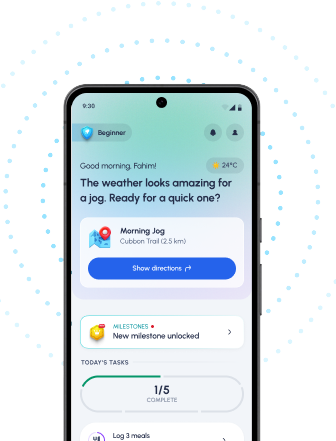Table of Contents
- Diabetes Fitness Basics: Exercise for Better Health
- Safe & Effective Workouts for People with Diabetes
- Creating a Diabetes-Friendly Fitness Plan: Your Guide
- Nutrition and Exercise: Double Your Diabetes Management
- Top 5 Exercises to Improve Diabetes and Wellbeing
- Frequently Asked Questions
- References
Living with diabetes doesn’t mean sacrificing an active and fulfilling life! In fact, regular exercise is crucial for managing your condition and improving overall wellbeing. That’s why we’ve created this guide, Diabetes Fitness Basics: Your Guide to Exercise and Wellbeing, to provide you with the essential information and practical advice you need to get started. We’ll explore safe and effective workouts, discuss important considerations for diabetics, and help you build a sustainable fitness routine. Ready to take control of your health and feel your best? Let’s begin!
Diabetes Fitness Basics: Exercise for Better Health
Managing diabetes effectively involves a holistic approach, and exercise plays a crucial role. A significant portion of the global diabetic population, 61% are aged between 20-64 years, highlighting the importance of early intervention and lifestyle changes. This is particularly relevant in Indian and tropical countries where lifestyle-related diseases are increasingly prevalent. For those aged 65+, representing 39% of those with diabetes, maintaining mobility and managing blood sugar through exercise becomes even more critical.
Finding the Right Fitness Routine
The key is to find enjoyable activities that fit your lifestyle and health condition. In hot and humid climates common in many Indian and tropical countries, consider adjusting your workout times to avoid peak heat. Early mornings or evenings are ideal. Focus on activities that don’t put excessive stress on your joints, such as swimming, walking, or yoga. These are particularly beneficial for older adults managing diabetes.
Actionable Tips for Success
* Start slowly and gradually increase intensity: Don’t push yourself too hard, especially if you’re new to exercise. Listen to your body and rest when needed.
* Incorporate strength training: Building muscle mass helps improve insulin sensitivity. Bodyweight exercises are a great starting point.
* Prioritize consistency over intensity: Aim for regular, moderate-intensity exercise rather than sporadic intense workouts. Even short bursts of activity throughout the day can be beneficial.
* Consult your doctor: Before starting any new exercise program, especially if you have any underlying health conditions, consult your doctor or a certified diabetes educator. They can help you create a safe and effective plan tailored to your needs.
Staying Active in Tropical Climates
Remember to stay hydrated, wear light clothing, and use sunscreen to protect yourself from the sun. Consider indoor exercise options during the hottest parts of the day. Find a workout buddy for motivation and support. Making exercise a social activity can increase adherence. For more information on the importance of regular exercise, check out Why Regular Exercise is Essential for Diabetes Management. This article provides valuable insights into how exercise impacts blood sugar control and overall well-being.
Ultimately, incorporating regular physical activity into your routine is essential for managing diabetes and improving overall well-being. Consult your doctor and find an exercise plan that works for you to live a healthier, more active life. If you’re looking for simple yet effective strategies, 10 Proven Tips to Effectively Manage Diabetes | Simple Guide offers practical advice to help you on your journey.
Safe & Effective Workouts for People with Diabetes
Managing diabetes effectively involves a holistic approach, encompassing diet and exercise. While the recommended carbohydrate intake varies, generally, aiming for 45–60 grams of carbs per meal is a common guideline for many individuals with diabetes, though this should always be personalized based on individual needs and consultation with a doctor or dietitian. Regular physical activity plays a crucial role in regulating blood sugar levels and improving overall health, especially in hot and humid climates prevalent in India and other tropical countries.
Choosing the Right Exercises
Opting for activities that suit the Indian and tropical climate is key. Avoid intense workouts during peak heat. Instead, focus on activities that can be performed in the early morning or late evening, when temperatures are cooler. Walking, swimming, and yoga are excellent choices. Walking is readily accessible and requires minimal equipment; swimming offers a low-impact, full-body workout; and yoga improves flexibility and stress management, both beneficial for diabetes management.
Important Considerations
Always consult your doctor before starting any new exercise program, particularly if you have any underlying health conditions. Stay hydrated, especially in hot climates. Carry water with you and drink frequently, even if you don’t feel thirsty. Monitor your blood sugar levels before, during, and after exercise to understand how your body responds to different activities. Listen to your body; rest when needed and don’t push yourself too hard, especially in the initial stages. For more tips on overall diabetes management, check out our article on 10 Proven Tips for Effective Diabetes Management.
Building a Sustainable Routine
Start slowly and gradually increase the intensity and duration of your workouts. Consistency is key. Aim for at least 30 minutes of moderate-intensity exercise most days of the week. Incorporate activities you enjoy to make it sustainable and enjoyable. Remember, even small changes can significantly impact your health and wellbeing. Finding a workout buddy can also provide motivation and accountability. Speak to your healthcare provider or a certified diabetes educator to create a personalized exercise plan suited to your specific needs and lifestyle in the Indian/tropical context. It’s also important to consider the impact of diabetes on your heart health. Learn more about protecting your heart with our guide, Protect Your Heart from Diabetes: 5 Essential Steps.
Creating a Diabetes-Friendly Fitness Plan: Your Guide
Regular physical activity is crucial for managing diabetes, especially in hot and humid climates prevalent across many Indian and tropical countries. The challenge is often adapting exercise routines to the weather and finding activities enjoyable and sustainable. According to the CDC, approximately 35 per 1,000 U.S. youths have diagnosed diabetes—a statistic highlighting the global need for accessible and culturally relevant fitness guidance. This underscores the importance of creating a plan that works for *you*.
Understanding Your Body and Climate
Before starting any fitness program, consult your doctor. In tropical climates, heat exhaustion is a significant concern. Choose exercises that are less strenuous during the hottest parts of the day. Early mornings or evenings offer cooler temperatures, ideal for brisk walking, yoga, or swimming. Remember to stay hydrated by drinking plenty of water, especially before, during, and after your workout.
Choosing the Right Activities
Consider activities that are culturally relevant and accessible. In many Indian and tropical countries, activities like yoga and walking are already deeply ingrained. Yoga is particularly beneficial as it improves flexibility, strength, and stress management—all important factors in diabetes management. Swimming is another excellent option, offering a low-impact cardiovascular workout that helps regulate blood sugar. Remember that managing your diet is also crucial, and you can learn more about creating a healthy eating plan with our guide on How to Lose Weight with Diabetes Diet Plan.
Building a Sustainable Routine
Start slowly and gradually increase the intensity and duration of your workouts. Consistency is key, so aim for at least 30 minutes of moderate-intensity exercise most days of the week. Listen to your body and rest when needed. Remember, a sustainable routine is more effective than an intense, short-lived one. Integrate fitness into your daily life; take the stairs instead of the elevator, walk or cycle instead of driving short distances whenever possible. Consider joining a local fitness group for added motivation and support. By adapting your fitness plan to the local climate and incorporating activities you enjoy, you can build a healthy and sustainable routine that empowers you to better manage your diabetes. If you’re pre-diabetic, check out our Pre Diabetic Diet Chart: Simple Plans to Prevent Diabetes for additional support in preventing the onset of type 2 diabetes.
Nutrition and Exercise: Double Your Diabetes Management
Managing diabetes effectively requires a holistic approach, combining careful nutrition with a regular exercise regime. This is especially crucial in hot and humid climates prevalent across India and tropical countries, where factors like dehydration and heat exhaustion can significantly impact blood sugar levels. Studies show that neglecting either aspect can lead to serious complications. For instance, smokers with diabetes face a doubled mortality risk due to cardiovascular issues. This highlights the importance of proactive health management.
Tailoring Your Fitness Plan
Choosing the right type of exercise is key. Consider activities that are suitable for the climate and your individual fitness level. Walking, yoga, and swimming are excellent low-impact options, particularly beneficial in hotter weather. Remember to stay hydrated throughout your workout. Incorporating regular, moderate-intensity exercises like brisk walking for at least 30 minutes most days of the week is recommended. The intensity and duration should be gradually increased based on your fitness level and doctor’s advice. Remember to consult your doctor before starting any new exercise program.
Nutrition for Diabetes Control in Tropical Climates
Proper nutrition plays a vital role in managing blood sugar levels. Focus on a balanced diet rich in fresh fruits, vegetables, and whole grains, common and readily available across the Indian subcontinent and other tropical regions. Limit processed foods, sugary drinks, and unhealthy fats. Consider incorporating spices like turmeric, known for its anti-inflammatory properties, into your meals. Regular blood sugar monitoring is crucial to track progress and adjust your nutrition and exercise plan accordingly.
Prioritizing both diet and exercise offers a powerful synergy in managing diabetes. By making informed choices and consulting with healthcare professionals, individuals with diabetes in India and tropical countries can significantly improve their health outcomes and quality of life. Start today and take control of your well-being! For more information on how lifestyle changes can impact your diabetes management, check out our article on 5 Easy Lifestyle Changes to Manage Type 2 Diabetes. Understanding the connection between obesity and diabetes is also crucial; you can learn more in our piece on Understanding the Link Between Diabetes and Obesity.
Top 5 Exercises to Improve Diabetes and Wellbeing
Walking: A Simple Yet Powerful Step
Walking is a fantastic, low-impact exercise, especially suitable for individuals in Indian and tropical climates. A brisk 30-minute walk most days of the week can significantly improve blood sugar control and cardiovascular health. Remember to stay hydrated, especially in hotter regions. This is crucial as women with diabetes, who face a 40% higher risk of heart disease compared to men with diabetes, need to prioritize cardiovascular health.
Yoga and Pilates: Flexibility and Strength
Yoga and Pilates are excellent for improving flexibility, strength, and balance – all important factors in managing diabetes. These practices are widely popular and accessible across India and tropical countries, offering a culturally relevant approach to fitness. Gentle stretches and controlled movements help manage weight, improve insulin sensitivity, and reduce stress.
Swimming: A Cooling Cardiovascular Workout
In warmer climates, swimming offers a refreshing and effective way to improve cardiovascular fitness. The buoyancy of the water supports joints, making it gentler on the body than land-based exercises. Regular swimming helps lower blood sugar levels and improve overall fitness, contributing to better diabetes management.
Cycling: Enjoyable and Effective
Cycling is a fun and low-impact exercise that can be easily incorporated into daily routines. It’s a great option for those living in urban or rural areas across India and tropical countries. Consistent cycling improves insulin sensitivity and helps manage weight, contributing to better blood sugar control.
Strength Training: Building Muscle Mass
Strength training is crucial for building muscle mass, which helps improve insulin sensitivity. Incorporating bodyweight exercises or using light weights are excellent options. Consult your doctor or a certified fitness professional to develop a safe and effective strength training program tailored to your specific needs and health conditions. Remember, managing diabetes effectively also involves making healthy lifestyle choices, including regular exercise. Prioritize your wellbeing! For more tips on healthy eating, check out 20 Best Foods for People with Diabetes – Tap Health. And for daily habits that can make a big difference, see 10 Daily Habits for Better Type 1 Diabetes Control.
Frequently Asked Questions
Q1. What is the most effective way to manage diabetes?
Managing diabetes effectively involves a holistic approach that combines a balanced diet with regular exercise. This is especially crucial in hot and humid climates.
Q2. What types of exercise are recommended for people with diabetes?
Low-impact exercises like walking, swimming, and yoga are recommended as they are adaptable to various fitness levels and climates. It’s important to start slowly and gradually increase intensity.
Q3. How can I stay motivated to exercise regularly?
Finding enjoyable activities and exercising with a workout buddy can significantly improve adherence to your exercise plan. Consistency is key, even if it means starting with shorter workouts.
Q4. Are there any specific considerations for exercising in hot and humid weather?
Staying well-hydrated is crucial, especially in tropical climates. Listen to your body and avoid exercising during the hottest parts of the day.
Q5. What should I do before starting a new exercise program?
It’s essential to consult your doctor before starting any new exercise program, especially if you have diabetes.
References
- A Practical Guide to Integrated Type 2 Diabetes Care: https://www.hse.ie/eng/services/list/2/primarycare/east-coast-diabetes-service/management-of-type-2-diabetes/diabetes-and-pregnancy/icgp-guide-to-integrated-type-2.pdf
- Your Guide to Diabetes: Type 1 and Type 2: https://www.niddk.nih.gov/-/media/Files/Diabetes/YourGuide2Diabetes_508.pdf




